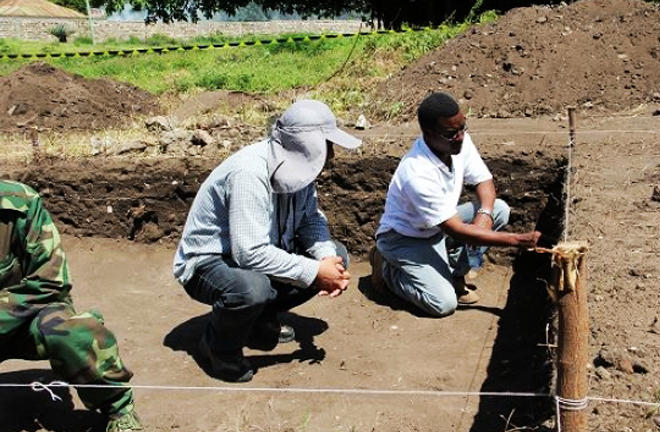African digs show extent of ancient porcelain trade

Peking University archaeology professor Qin Dashu (middle) communiates with a foreign scholar during an excavation in Kenya.
Chinese archaeologists digging on the eastern coast of Africa have discovered evidence of extensive, high-volume porcelain trade in ancient China.
The excavations are part of a large-scale research project on trade along the ancient maritime Silk Road supported by the National Sciences Fund and headed by Peking University archaeology professor Qin Dashu.
“The development of underwater archaeology in recent years has made it possible to retrieve a growing number of relics from the seafloor,” Qin said, adding that the new findings indicate Chinese pottery was exported to countries around the world on a much larger scale than scholars used to believe.
China began exporting porcelain on a large scale in the seventh century under the Tang Dynasty. Trade in porcelain lasted for more than 1,000 years, providing crucial proof of the exchange between ancient China and foreign countries.
Qin is an expert in the archaeology of ancient ceramics, particularly artifacts of the Song, Yuan and Ming dynasties. He carried out three archaeological excavations in Kenya from 2010 to 2013.
Through years of archaeological work, large quantities of Chinese pottery have been unearthed at sites in coastal countries of East Asia, Southeast Asia, South Asia, the Middle East, Africa and America. The excavated porcelain dates from the Tang Dynasty to the late Qing Dynasty.
Prior to the 21st century, it was mainly Western and Japanese archaeologists who led excavations of important sites along the route of maritime trade, but Chinese scholars are increasingly becoming involved.
So far Chinese archaeologists have not only conducted a great deal of underwater excavation in the seas surrounding China but also actively joined archaeological work in Southeast Asian countries, such as Cambodia, Singapore and Vietnam.
Chinese archaeologists also discovered Chinese pottery in locations at the western terminus of the maritime Silk Road, including the Fustat site in Egypt and the Lamu Archipelago in Kenya.
“Although Africa is far from China, Chinese archaeologists have done no less archaeological research in Africa, discovering the most and finest export porcelain on the Indian Ocean Rim,” Qin said.
In addition to statistical analysis of artifacts discovered in Africa, Qin’s project will also evaluate samples of exported Chinese porcelain qualitatively to establish a database of its common characteristics, thereby providing basic data support for further study and forming the basis for archaeology-based multidisciplinary research, Qin said.
“Through research, we aim to build a chronological series spanning from the beginnings of mass export of porcelain to the late Qing Dynasty and scrutinize the features and quantities of the porcelain trade in different stages,” Qin said.
Ding Yu, a scholar from the School of History at Beijing Normal University, participated in the archaeological excavations in Kenya a few years ago and is currently involved in the project. He said he attempts to look back on the maritime Silk Road from the perspective of Africa and study the role ancient Chinese porcelain played in shaping African culture and society.
Exported Chinese porcelain has value not only as a relic of ancient Chinese culture but also as an embodiment of the absorbed elements of local culture, Ding said, adding that it offers important evidence of the integration between Chinese and world cultures.
Through proactive, in-depth research on the field, scholars can properly recognize the status of ancient China in international trade and its contributions to early economic globalization, he said.
Given China’s rising status in the international community, studies of ancient export porcelain can provide more perspectives that will allow other countries to better understand and study China. In recent years, a number of international projects and conferences on ancient Chinese export porcelain have been launched.
Qin stressed the importance of investigating the porcelain unearthed in Africa and comparing it with new porcelain-related archaeological results. The move can be conducive to interpreting the role of Chinese porcelain in ancient sea trade, reconsidering the status and global influence of ancient Chinese marine culture in social life and rewriting the history of ancient Chinese material culture and foreign exchanges, he said.
Zeng Jiang and Zhao Xuzhou are reporters at the Chinese Social Sciences Today.
